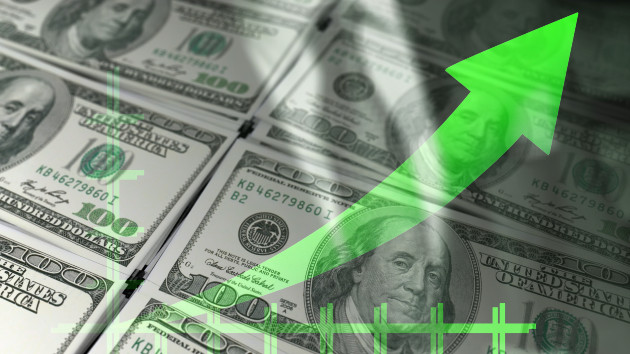
(NEW YORK) — As the midterm elections approach, sky-high prices for essentials like gas and groceries continue to weigh on U.S. consumers. The price of eggs stands about 30% higher than it did a year ago, while the cost at the pump has spiked 11% over that same period.
In turn, polls show economic concerns remain top of mind for voters, who on this issue tend to distrust the Democratic Party, which has held the White House and Congress as inflation has spiked.
The share of likely voters who say economic issues are the most important concerns facing America stands at 44%, a jump from 36% who said so in July, according to a New York Times/Siena poll released last week. Those economy-focused voters overwhelmingly preferred Republicans, by more than a two-to-one margin, the poll said.
In a similar poll, released by NBC News last month, voters favored Republicans by nearly 20 percentage points on the issue of the economy.
While eye-popping price hikes appear a key driver behind voter preferences for Republicans, the party’s proposals for how to address the rising costs have garnered less attention.
Republican policy ideas for attacking inflation — such as a spending cut and an increase of U.S. oil output — could help reduce inflation, but face difficulty doing so in the short term, economists told ABC News. In some cases, the proposals do not differ significantly from solutions put forward by Democrats, the economists added.
The Federal Reserve, the economists said, plays a more immediate role than Congress in addressing inflation. They also noted that price hikes have pummeled countries across the world, even as they have pursued different policy measures.
Here’s what Republicans say they will do to address inflation, and how economists assess the proposals:
Slash spending
On the campaign trail, many Republican candidates have criticized President Joe Biden and Congressional Democrats for expansive spending, which Republicans say directly led to the spike in prices. Specifically, the Democrats have faced criticism for the American Rescue Plan, a $1.9 trillion economic stimulus measure signed into law by Biden in March 2021 in response to the pandemic.
While the Biden measure comprised a major spending package, former President Donald Trump backed even greater coronavirus-related spending, signing into law a package in December 2020 worth $2.3 trillion.
Pandemic-era spending likely did contribute to the current price spike, juicing demand for goods and services while the country faced a shortage of supply, economists said. A spending cut could alleviate some of the pressure on prices and help ensure that it doesn’t get worse, they added.
Democratic leaders have warned that Republican spending cuts could shrink social welfare programs like Medicare and Social Security, which Biden has vowed to preserve.
Maya MacGuineas, the president of the nonprofit Committee for a Responsible Federal Budget, said the government’s borrowing to pay for the spending increase made up the key driver of inflation.
“We’re spending so much and not paying for it — that additional money in the economy has driven inflation,” she said. “Cutting spending is a very desirable way to improve the inflation government that we’re currently in.”
While the Republican Party traditionally touts fiscal responsibility, its recent record on the issue belies that reputation, economists said.
The federal debt grew by almost $7.8 trillion over the course of the Trump administration, the third-largest increase, relative to the size of the economy, of any U.S. presidential administration, according to a calculation by Eugene Steuerle, co-founder of the Urban-Brookings Tax Policy Center, ProPublica reported.
As of last month, Biden had added $4.8 trillion to the federal debt, which outpaces the $2.5 trillion that Trump had incurred at this point in his term, according to the Committee for a Responsible Federal Budget.
Ease supply chain bottleneck
In addition to federal spending that has bolstered consumer demand, Republican candidates have targeted a supply chain bottleneck that has curtailed supply.
During the pandemic, COVID-related bottlenecks slowed delivery times and infection fears kept workers on the sidelines, leading to a shortage of goods and workers.
Commitment to America, a plan put forward by Republican House Minority Leader Kevin McCarthy, laments the “broken supply chain that has increased costs and left store shelves empty.” The plan vows to fix the supply chain issues, including a transfer of additional productive capacity to the U.S. in order to alleviate reliance on China.
The supply chain bottleneck has improved since the height of the pandemic, but remains a driver of high costs, economists said.
Efforts to ease the supply chain blockage and bring more production to the U.S. — which have drawn support from Democrats and Republicans alike — could help lower prices, though in the short term progress on the issue will depend in part on decisions made in other countries, the economists added.
Giacomo Santangelo, an economist at Fordham University, compared the supply chain bottleneck to an air bubble that blocks water from flowing through a pipe. Initially, the blockage stood close to the source of goods, effectively halting the freight ships that transport products, the port workers and truckers who deliver them, and the retail stores that sell them.
Now, that air bubble has moved closer to the mouth of the pipe, as shipping wait times have decreased and retail stores have reopened, Santangelo added.
But ongoing coronavirus-related shutdowns in China remain a key sticking point for the supply chain, spurring bipartisan calls for more production on U.S. soil, the economists said. The CHIPS and Science Act, a measure supported by members of both parties and signed by Biden in August, provides funding for domestic semiconductor manufacturing.
Additional measures pushed by a Republican Congress could help alleviate inflation in the long term, but will not address the role that supply chain bottlenecks in China have played in elevating current prices, John Horn, a professor of practice in economics at Washington University in St. Louis, told ABC News.
“Those changes take a long time to put in place,” Horn said. “To change China’s COVID policy to ramp up production in China — a Republican Congress won’t help with that.”
“A lot of these supply chain bottlenecks elsewhere in the world won’t be able to be affected by Congress,” he added.
Expand U.S. oil and gas production
A major source of frustration over inflation centers on gas prices, which crunch budgets and appear on roadside signs nationwide.
The high prices are due to a shortage of crude oil supply amid the Russian invasion of Ukraine, as well as a cut in production imposed by an alliance of oil-producing countries called OPEC+. Meanwhile, a longstanding oil supply shortage endures from a pandemic-induced production slowdown that hasn’t caught up with a bounce back in demand.
For context, the world consumed nearly 100 million barrels of oil each day in August, the most recent month on record, according to the EIA.
The U.S. is set to produce an average of 11.8 million barrels oil per day in 2022, which stands 500,000 barrels short of a record set in 2019, EIA data showed.
“We can attempt to influence gas prices, but gas prices are determined by global markets, which are affected by geopolitical changes,” Santangelo said.
Copyright © 2022, ABC Audio. All rights reserved.




